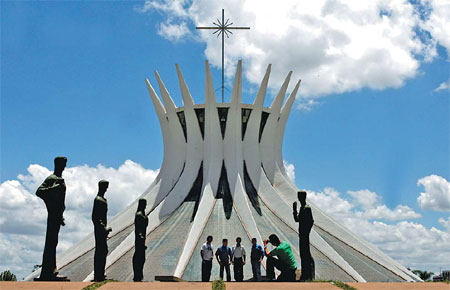Renowned architect remembered
(Agencies/China Daily) Updated: 2012-12-08 08:33Internationally renowned architect Oscar Niemeyer was being honored on Thursday with a memorial in Brasilia, the modernist Brazilian capital he helped design out of the country's vast interior plain with signature buildings of flowing concrete and grand, sweeping curves.
Niemeyer's remains were flown by presidential plane to the capital from his native city Rio de Janeiro, where he died on Wednesday night at the age of 104. Elisa Barboux, a spokeswoman for the Hospital Samaritano in Rio, said the cause of death was a respiratory infection.
 |
|
The Metropolitan Cathedral in Brasilia, Brazil, which was designed by architect Oscar Niemeyer, who died in Rio de Janeiro on Wednesday at 104. Jamil Bittar / Reuters |
After the flight in a plane loaned by President Dilma Rousseff, the cremated remains of the groundbreaking architect were to rest in the presidential palace, a deceptively simple building of glass and concrete that seems nearly weightless, an airy glass structure held aloft by vast, curving white pillars. After a vigil and public visitation, his ashes were scheduled to be returned to Rio for burial on Friday.
Rio's governor, Sergio Cabral, called for three days of mourning. "His manner was gentle, his convictions were firm, and he was loved by the Brazilian people," Cabral said in a statement.
Born into an elite family, Niemeyer was a lifelong communist who took a stand against social inequality in one of the most unequal nations on Earth, though he held no illusions his work could create a more egalitarian nation.
Rousseff described Niemeyer as "revolutionary," saying in a statement that he was "the mentor of a new architecture that was beautiful, logical, and as he himself defined it, inventive".
Sergio Magalhaes, president of the Brazilian Institute of Architects, said: "Beyond being an architect, Niemeyer was a man ahead of his time, who stood in solidarity with the people and who was loved as few have been."
In works that ranged from Brasilia's crown-shaped cathedral to the undulating French Communist Party building in Paris, Niemeyer shunned the steel-box structures of many modernist architects, finding inspiration in nature's crescents and spirals. His hallmarks include much of the United Nations complex in New York and the Museum of Modern Art in Niteroi, which is perched like a flying saucer across Guanabara Bay from Rio de Janeiro.
"Right angles don't attract me. Nor straight, hard and inflexible lines created by man," Niemeyer wrote in The Curves of Time, his 1998 memoir. "What attracts me are free and sensual curves. The curves we find in mountains, in the waves of the sea, in the body of the woman we love."
His curves give sweep and grace to Brasilia, the city that opened up Brazil's vast interior in the 1960s and moved the nation's capital from coastal Rio.
Niemeyer designed most of the city's important buildings, while French-born, avant-garde architect Lucio Costa crafted its distinctive airplane-like layout. Niemeyer left his mark in the flowing concrete of the Cabinet ministries and the monumental dome of the national museum.
As the city grew to 2 million, critics said it lacked soul as well as street corners, "a utopian horror", in the words of art critic Robert Hughes.
Niemeyer shrugged off his critics and kept working until the days before his death, with engineers visiting his hospital room to talk over pending projects.
His admirers said Niemeyer's work make him an eternal figure, whose influence on his nation won't fade.
"A few days ago, I heard something I really liked - Oscar will never die," Paulo Enrique Paranhos, who leads the Brasilia branch of the Brazilian Institute of Architects, told the Globo TV network. "It's not an exaggeration for those of us who love architecture."







